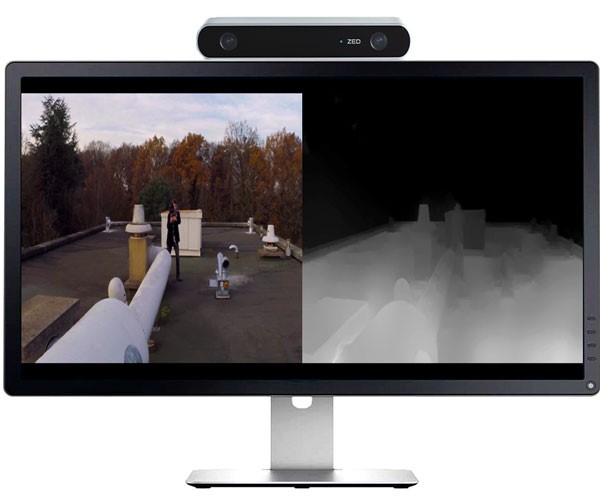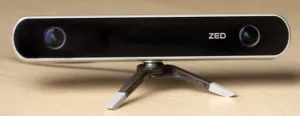The Zed stereo camera, produced by Stereolabs Inc. (San Francisco, CA), is a lightweight depth sensor that can capture scenes in 3D in both indoor and outdoor venues. The depth information can then be used, for example, to create 3D models and maps or for robot and drone collision avoidance and/or navigation. The depth resolution of the system is the same as the video resolution.
The Zed stereo camera technology is based on the use of passive sensors mounted 120 mm apart. The output of the Zed stereo camera output consists of two synchronized left and right video streams. Using the Zed SDK, the graphics processing unit in the host computer calculates the depth map from the side-by-side video by determining the distance in pixels between similar features in the two images. The calculations are accomplished in real-time with the result being an estimate of the depth or distance from the camera to objects in the scene.
The Zed SDK requires a dual core processor that runs at 2.3GHz or faster, 4 GB of RAM, an Nvidia CUDA-compatible graphics card with a compute capability of 2.0 or better, a USB 3.0 port, and Windows 7, 8 or 8.1. For high resolution capture, Zed recommends using a SSD with 250MB/s transfer speeds or faster for storage.
The company claims that the algorithms to do the calculations use few computing resources. Based on these capabilities, the company believes that the system is well suited for embedded applications.
Some of the specifications of the camera system include:
- Output resolution is 4416 x 1242 pixels in a 16 x 9 wide screen format at 15 fps.
- The resolution at other frame rates are as follows: 3840 x 1080 at 30 fps, 2560 x 720 at 60 fps and 1280 x 480 at 120 fps.
- Depth sensing extends over a range of 1.5 to 20 metres.
In the Zed system, as is the case for all stereo depth capture systems based on the use of two cameras, calibration is a major concern. Calibration in the context of this product application includes optical and mechanical misalignment, vertical shift, roll, height, tilt, convergence, zoom, focus, iris and color. The need for calibration is especially critical in real-time applications since the two images cannot be “tuned up” at a later time.
To address the issue of calibration, the Stereolabs system is recalibrated on-the-fly. By correcting any errors in real time, Zed claims to bring real-time stereoscopy to embedded systems.

A video illustrating the Zed system in use can be found at the end of this article.
Zed stereoscopic vision equipment is now commercially available. The selling price of $449. This price point is represented as “inexpensive” for this type of equipment. – Arthur Berman

